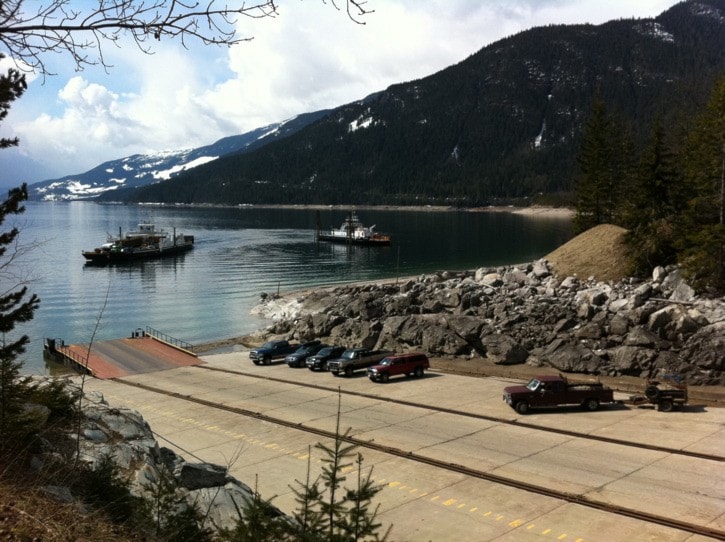Since the reservoir was flooded in the late 1960s, there’s been at least some support in the Arrow Lakes area for fixed crossings (bridges) to replace ferry routes on the lake/reservoir.
A Nakusp-based lobby group suspended their active lobbying about five years ago, citing a lack of political support in Victoria. However, a new group in the Nakusp area has picked up the torch and become vocal advocates for a link between Galena Bay and Revelstoke.
The Beaton Arm Crossing Association (BACA) has gathered about 700 signatures and numerous letters in support of the idea, and are trying to breathe life into the concept again.
They’ve put together a business plan that explores various bridges and highways configurations.
BACA president Earl Frerichs said they’ve presented their plans to the B.C. transportation ministry, but they haven’t got a response.
“We haven’t heard back from them yet,” Frerichs said, and they’re awaiting an answer, despite a prevailing belief that it will be a negative one. Until then, “there’s not much point in us mounting any kind of an offense.”
He predicts a planned new ferry will be a disaster.
“It’s going to take an hour and a half to make a trip,” he said. “In the summer ... it’s not going to handle the load,” he said.
For Frerichs, the new crossing is a matter of survival for communities in the Arrow Lakes area.
“The town of Nakusp is dying,” Frerichs said. He spoke of newly-listed restaurants for sale and the cancellation of several annual events including the 2012 Nakusp Music Fest. “What is going to go on in Nakusp that’s going to keep the town going?” A fixed link would be a key stimulus, he says.
For residents of the Arrow Lakes region, the idea of building a fixed link is more than just a transportation improvement. Many are convinced that the lack of a fixed crossing has greatly impeded the West Kootenay region’s economic development. The free ferries at Shelter Bay and the cable ferry at Fauquier limit connectivity to the west and north. The bridges also carry much historical political baggage. They are a reminder of what the region gave up when the Arrow Lakes reservoir was flooded, and past promises to build bridges.
In their current round of lobbying, BACA has also lined up some political support; local NDP MLAs Katrine Conroy and Norm Macdonald have penned letters expressing support for more studying of the concept. Arrow Lakes area businesses and politicians have also written letters of support for further study of the concept.
They’ve presented their plans to transportation ministry staff, but so far, it doesn’t appear the new lobby is getting any traction in Victoria.
And unlike past perennial efforts, the lobby is now racing against the clock. The B.C. Ministry of Transportation has announced they’re building a new, bigger ferry to replace the existing two aging ferries that ply the route from Shelter Bay to Galena Bay.
A ministry spokesperson told the Times Review the request for proposals for that ferry will be issued to shortlisted companies this month. The plan is to build a ferry that can hold the ‘equivalent’ of 80 cars. The DEV Galena is the larger of the two ferries in operation. It can hold the equivalent of 50 cars, but also has weight restrictions that can reduce its capacity to the equivalent of 40 cars.
And the ministry says it isn’t considering a fixed crossing. They cite a 2004 study exploring fixed link options. The ministry-commissioned study said bridges could cost over $500 million. “Current and forecast traffic demands can be met with a ferry,” the ministry spokesperson wrote in response to our questions.
They said volumes and traffic demands in the Kootenays can be met with the existing road network.
Nakusp mayor Karen Hamling said she supports the concept of a new fixed link, but says the lobby effort could take five or ten years, and that something needs to be done in the meantime. “A fixed link would be an economic asset to our community,” she said in a Jan. 23 interview. For now, the ferry will have to do: “Although it will not entirely mitigate the long ferry waits in the summer, we need something in place until a fixed link becomes a reality,” Hamling wrote.
In a telephone interview last week, Revelstoke mayor David Raven said that Revelstoke city council’s transportation infrastructure priority was the Trans-Canada Highway. “We understand the fixed crossing thing, however, the ferries need to be replaced now,” Raven said. “We are more concerned with the Trans-Canada than we are with [Highway] 23 South. The Trans-Canada’s an immediate priority for us,” he said.
Raven said the City of Revelstoke hadn’t been involved in any lobbying as to where the ferry would be fabricated, though they’d welcome the jobs. Raven, who is originally from Nakusp, said the existing ferries were built in Vancouver shipyards and moved here in pieces for assembly. He believed that happened on beaches in Castlegar and Burton.
So, what will BACA do when if (and likely when) they get a definitive ‘no’ from the provice? “We’ll keep pushing ahead,” Frerichs said. “We can get some federal money.” Their goal is to pursue getting on a long-term provincial transportation plan. “They made up their mind five years ago what they’re going to do,” he says.
“Are we disillusioned? Not really,” Frerichs adds. “We’re not surprised.”
